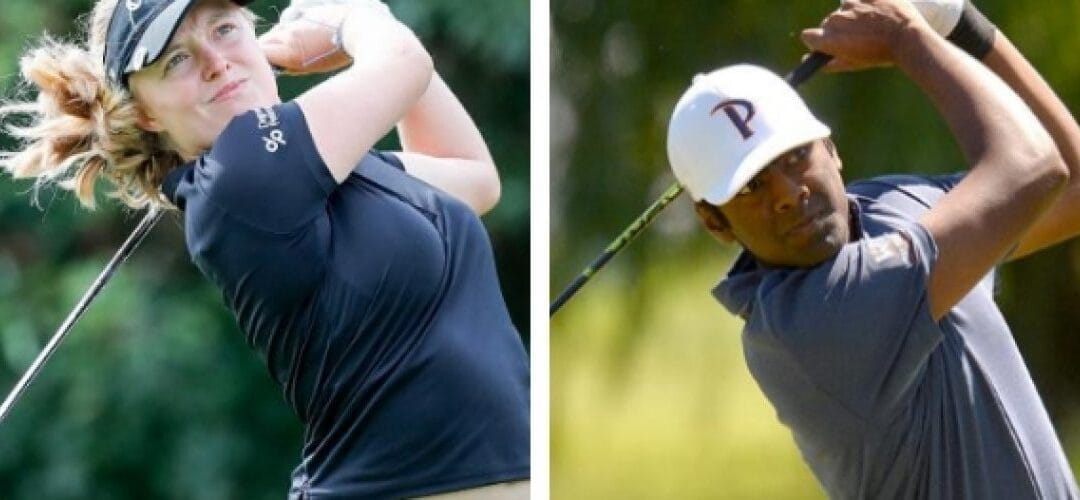By Paul Culp, MA (Oxon.), CFT, GCDF, CCSP
The NCAA has just set the fields for the men’s and women’s golf championships, and we’re confident that the increased exposure for the sport at this time of year will spur some interest in golf scholarships among high-schoolers who haven’t previously considered them, as well as further motivating those who were already attentive to these matters. The NCAA has also released some new recruiting rules for golf, so now is an excellent time to work golf into our series on athletic scholarships, which so far has addressed football, baseball, basketball, women’s soccer, women’s volleyball, and lacrosse, along with research on athletic scholarships in general (The “How Many” and “How Much” of Athletic Scholarships and The “How To” of Athletic Scholarships Explained).
According to Scholarshipstats.com, one high school athlete in 14 goes on to compete in a varsity sport in college, but only one in 54 makes the grade in NCAA Division I. The largest percentage is in Division III, which does not provide athletic scholarships, but we’ll explain shortly why sports are nonetheless important in the D3 financial aid picture.

Like many other sports, golf will afford you the opportunity in later years to boast about how cool you were in your prime.
About 144,000 high school boys in the United States play golf (for some perspective, compare that with 550,000 for basketball) while 12,000 male players compete in college. Scholarshipstats.com reports that there are 1,248 men’s teams: 299 in Division I, 228 in Division II, 304 in Division III, 174 in the NAIA, and 171 in the NJCAA, with “other four-year” and “other two-year” accounting for the remainder. Not quite seven percent of high-school golfers compete at some collegiate level. The odds of making an NCAA or NAIA roster are about 17:1, which doesn’t sound too bad—but only 1.6 percent of male high school golfers eventually compete in Division I.
The odds factor in some stout competition from foreign athletes, who account for 14 percent of male Division I and Division II golfers.
Approximately 79,000 high school girls play golf, with just over 7,000 competing in college, on 961 teams: 267 in Division I, 194 in Division II, 228 in Division III, 164 in the NAIA, and 66 in the NJCAA, with the “other” categories accounting for the rest. Slightly more than 8 percent of high-schoolers go on to compete in some collegiate stratum, and the odds of doing so are about 16:1, with 2 percent of high-schoolers making it to Division I.
Foreign competition is even more arduous for female golfers than it is for the men: 20 percent of Division I women’s golfers are foreign, and 12 percent in D2.
So how many golf scholarships are there?
First let’s consider average team size, which for men is 10 in Divisions I and II and in the NAIA, 11 in the non-scholarship Division III, and seven in the NJCAA. The women’s numbers are 8,8,7,7, and 5. Female golfers and their parents will be pleased to learn that despite the smaller rosters, the scholarship limits are more generous for women: 6 per team in Division I, 5.4 in Division II, five in the NAIA, and eight in the NJCAA. For the men and their larger rosters, the figures are 4.5 in Division I, 3.6 in Division II, five in the NAIA, and eight in the NJCAA.
Here, as with most of the other sports we’ve written about, it’s necessary to explain what it means to be “on scholarship.” Not all sports are head-count sports, meaning sports in which scholarships are awarded at a ratio of one full scholarship per athlete—in other words, the highly coveted full free ride. Far more common are equivalency sports, in which coaches can divide one scholarship among as many athletes as they see fit. Golf scholarships fall into the latter category.
The average men’s golf scholarship is worth about $13,000, with the highest reported figure being $29,000 and the lowest $4,000—but on average the scholarships are being carved up nine different ways, with a low of six and a high of 16. Roster sizes can vary greatly, which accounts for the extreme variation in scholarship distribution. The average women’s golf scholarship is about $22,000, with a high of $41,000 and a low of $5,500. The average number of scholarships per team is eight, with a high of 12 and a low of five.
Note that with golf scholarships the women have it better than the men: fewer athletes getting more money. This continues a pattern we have observed in multiple other sports, and indeed women overall receive more per athlete than men do throughout college athletics as a whole.
Whether or not you like what you’ve seen so far, remember that the golf scholarship limit is per program, not per year. The number of players returning can limit the number of scholarships available for incoming freshmen and can affect whether and how a scholarship is distributed among multiple athletes.
As we pointed out in our oft-cited An Arm and a Leg and Your First-born Child: Why College Costs So Much, the average cost of tuition and fees for the 2017–2018 school year was $34,740 at private colleges and universities, $9,970 for state residents at public institutions, and $25,620 for out-of-state residents attending public institutions. Compare that with the scholarship averages above, and take note that athletic scholarships do not exclude other forms of financial aid.
Now, what of NCAA Division III? While Division III programs do not offer athletic scholarships, sports can still be a ticket to financial aid, a component of an extracurricular resume that colleges consider strongly in making decisions about whom to admit and whether to bestow fiscal assistance. Thus it is possible, even without athletic scholarships, for athletic prowess and the desire to perform at the college level to play a role in the acquisition of financial aid for student-athletes applying at Division III schools.
So, how good do you have to be to merit a golf scholarship? We’re grateful to Athleticscholarships.net for these two visual aids:


In the words of their house expert, David Frank, “These are the general guidelines for what coaches look for in a golfer. If you fall outside of these general requirements it is still possible to play at that level, but there will be fewer opportunities.”
Readers who are already somewhat informed about golf scholarships and the recruiting process will be especially interested in the rule changes we referred to earlier. According to Golfweek:
After a players [sic] sophomore year, June 15th is the first time for recruiting interaction through correspondence, private messages and incoming and outgoing telephone calls.
August 1st after a players [sic] sophomore year is the first date where a player can make unofficial and official visits, along with off-campus contact.
Golf scholarships, like other scholarships, usually go to people who are strategic.
We at The Coaching Educator cannot emphasize strongly enough the importance of having a strategy not only for pursuing athletic scholarships but also for combining them with other forms of financial aid. A decade of experience helps us help you stay on schedule and on task, in contact with the right people, and within the rules. We’re here to help students and their families make sense of an increasingly complicated procedure and find ways to overcome the ever-increasing expense of college for athletes and non-athletes alike.
To learn more about our philosophy and capabilities, be sure to watch our free webinars, listen to our podcasts, sign up for our four-week College App Boot Camp, consider our Ultimate Programs and our special services for athletes and performing-arts students, and book a consultation to hear what we can do for you and how we do it. Keep reading this blog, and look for us on social media (see links below) as we keep our clients and admirers advised of new developments in our effort to help students get into and succeed at the right school.
Paul Culp is certified as a global career development facilitator and writes about college admissions, college costs, financial aid, and college life in general for The Coaching Educator team. A former journalist and corporate ghostwriter who now operates Shenandoah Proofreading, Editing & Composition Services (SPECS), he has also been a humanities teacher at all levels from university down to sixth grade. Paul has degrees from Oxford University, Jacksonville State University, and Samford University, and also is certified as a fitness trainer.
Featured Images: Pepperdine University men’s golf, University of New Mexico women’s golf
Recommended Reading About College Admissions and Athletic Scholarships
Culp, Paul. “An Arm and a Leg and Your First-born Child: Why College Costs So Much, The Coaching Educator, http://tce.local/2018/09/06/an-arm-and-a-leg-and-your-first-born-child-why-college-costs-so-much/
Culp, Paul. “Baseball Scholarships by the Numbers,” The Coaching Educator, 15 April 2019, http://tce.local/2019/04/15/baseball-scholarships-by-the-numbers/
Culp, Paul. “Basketball Scholarships by the Numbers,” The Coaching Educator, 4 April 2019, http://tce.local/2019/04/04/basketball-scholarships-by-the-numbers/
Culp, Paul. “Football Scholarships by the Numbers,” The Coaching Educator, 17 April 2019, http://tce.local/2019/04/17/football-scholarships-by-the-numbers/
Culp, Paul. “The ‘How Many’ and ‘How Much’ of Athletic Scholarships,” The Coaching Educator, 18 September 2018, http://tce.local/2018/09/18/the-how-many-and-how-much-of-athletic-scholarships/
Culp, Paul. “The ‘How To’ of Athletic Scholarships Explained,” The Coaching Educator, 24 November 2018, http://tce.local/2018/11/24/the-how-to-of-athletic-scholarships-explained/
Culp, Paul. “Lacrosse Scholarships by the Numbers,” The Coaching Educator, 6 December 2018, http://tce.local/2018/12/06/lacrosse-scholarships-by-the-numbers/
Culp, Paul. “Ten Unusual Athletic Scholarships, The Coaching Educator, 8 March 2019, http://tce.local/2019/04/08/ten-unusual-athletic-scholarships/
Culp, Paul. “Why Scholarship Athletes Quit,” The Coaching Educator, 25 February 2019, http://tce.local/2019/02/25/why-scholarship-athletes-quit/
Culp, Paul. “Women’s Soccer Scholarships by the Numbers,” The Coaching Educator, 23 October 2018, http://tce.local/2018/10/23/womens-soccer-scholarships-by-the-numbers/?fbclid=IwAR1tqZ-uyy8Kjw8krJDl–ERyuxUF_lt2uVfcqFqbNtmQDDTQvvBK7EOhJ8
Culp, Paul. “Women’s Volleyball Scholarships by the Numbers,” The Coaching Educator, 10 October 2018, http://tce.local/2018/10/10/womens-volleyball-scholarships-by-the-numbers/

